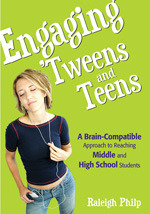Engaging 'Tweens and Teens
A Brain-Compatible Approach to Reaching Middle and High School Students
- Raleigh Philp - Pepperdine University, USA
• Recognizing and being able to respond to the emotional states teens commonly experience
• Frequently changing students' physiological states to prevent them from getting bored or mentally checking out during instruction
• Incorporating technologies teens use into classroom instruction and discussion, such as cell phones, weblogs, wikis, digital cameras, iPods, and Sidekicks
• Enlivening class with music students will respond to, from classical to pop to hip hop
The book also discusses the effects of stress on learning, and explores common teen risk-taking behaviours, such as violence and substance abuse. The final chapter addresses academic performance-enhancing drugs students are increasingly taking in response to the pressures of standardized testing. Teachers' awareness of, and ability to respond to, this problem is of growing importance.
Teachers will gain an understand of the changes taking place in the teen brain and be ready to adapt teaching so it is more intentional and appropriate, resulting in meaningful learning experiences for teenage students.
"A remarkable blend of scientific and practical strategies. Full of heart, creativity, scientific veracity, and wisdom. A must-read for all educators who want to get inside the teenage brain."
"Discusses a variety of neuroscientific findings relevant to classroom teachers and their students, and includes many practical tips. A tremendous resource for educators and parents!"
"Masterfully distills brain research into easily understood concepts, connecting each to simple teaching methods that lead to peak academic performance."
"Explains the latest advances in neuro-cognitive science and supports them with practical classroom applications. This book demystifies the what, why, and how of brain-compatible teaching."
"Easier to read than most, because of the excellent text structure, illustrations, and attractive layout. This book can be used as a 1-chapter, 20-minute study with an application strategy; such a mini-workshop exercise can be both fun and instructive."
